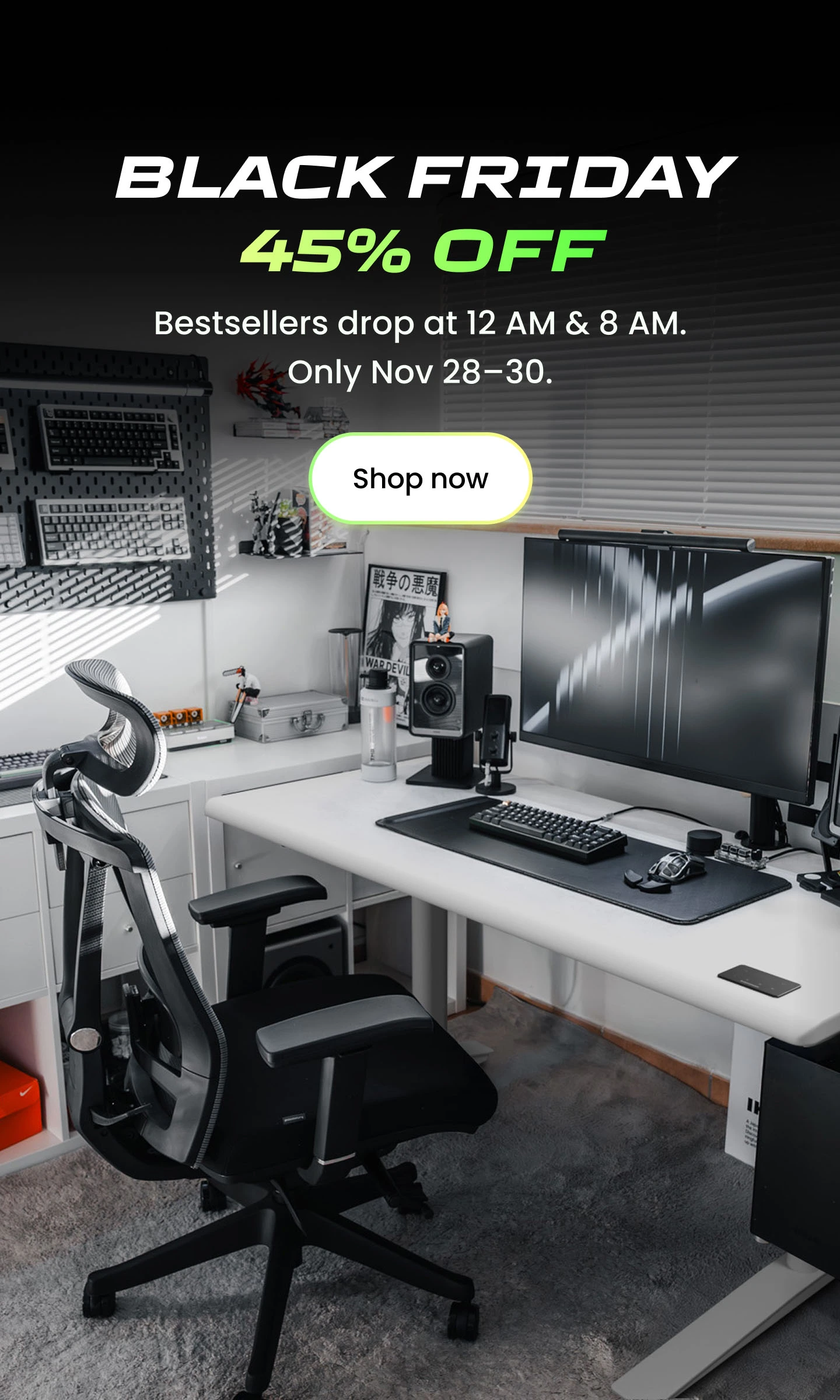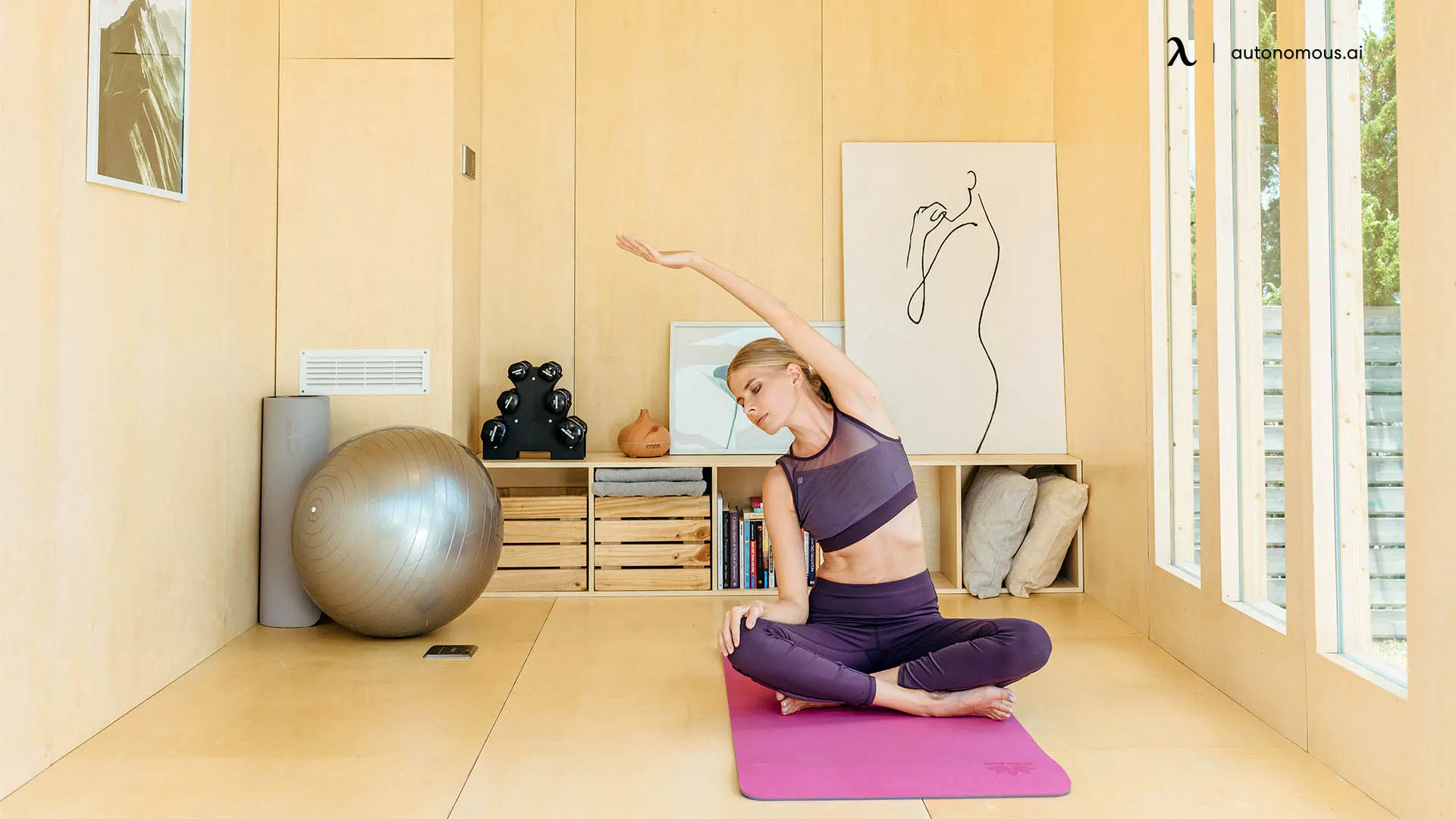
Easy 15-Minute Chair Exercises For Seniors To Do At Home
Table of Contents
Staying active can be simple and safe. Chair exercises for seniors help you build strength, improve balance, and loosen stiff joints without leaving your home. This guide explains what to do, how often, and how to adjust for comfort.
If you prefer a quick routine, try our 15-minute chair exercises for seniors to boost energy and confidence in one short session. Start where you are, move at your pace, and use a sturdy office chair. Small steps add up to better mobility and everyday independence.
Benefits of Chair Exercises For Seniors
Staying active later in life not only promotes physical health but also boosts emotional well-being and independence. By integrating a straightforward yet effective chair workout for seniors into a daily routine, individuals can enjoy a range of benefits, including:
- Heart and circulation: Better blood flow and blood pressure support.
- Balance and stability: Stronger legs and core lower fall risk.
- Mobility and flexibility: Easier walking, bending, and reaching.
- Mood and focus: Light movement lifts energy and reduces stress.
- Independence: More strength for standing up and daily tasks.
For those with lower back discomfort or nerve irritation, chair stretches for sciatica can provide relief. These gentle, seated stretches ease pressure on the sciatic nerve and improve spinal alignment—all from a chair. You don’t need expensive equipment; a good chair is all you need to start the workouts at home.
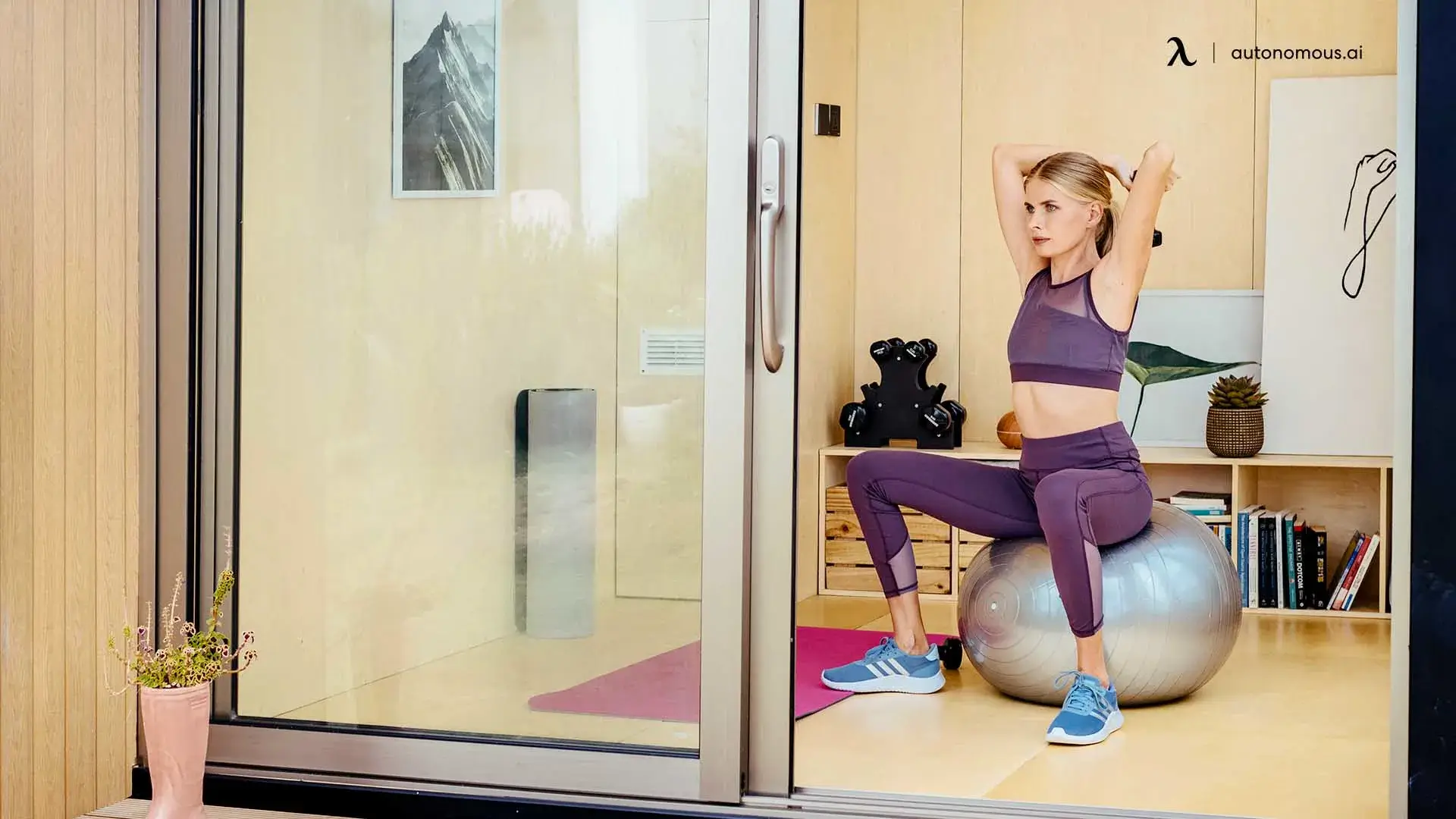
The Best Chair Workouts For Seniors
Success here comes from consistency and easy-to-follow moves, not intensity. The office chair exercises below are practical and joint-friendly; use them as a quick circuit for a 15-minute chair exercise routine for seniors or mix and match based on how you feel. Begin in a pain-free range, breathe naturally, and progress at a comfortable pace.
1. Seated Marching
A gentle way to warm up safely, loosen hips, and boost circulation. This can also be paired with simple seated stretching exercises to loosen the body before moving into more focused routines.
Setup: Use a sturdy, armless chair on a non-slip surface. Sit tall near the front of the seat with feet flat and knees hip-width apart. Lightly hold the sides of the chair.
Instructions: Do 45 seconds of work, 15 seconds rest
- Step 1: Sit up tall.
- Step 2: Lift your right knee like you’re marching.
- Step 3: Put your right foot down gently.
- Step 4: Repeat with your left knee.
- Step 5: Keep switching legs at a steady, comfortable pace.
Safety notes: Stop if you feel pain, dizziness, or shortness of breath. If you have hip or low-back issues, lift the knees only a little and stay in a pain-free range.
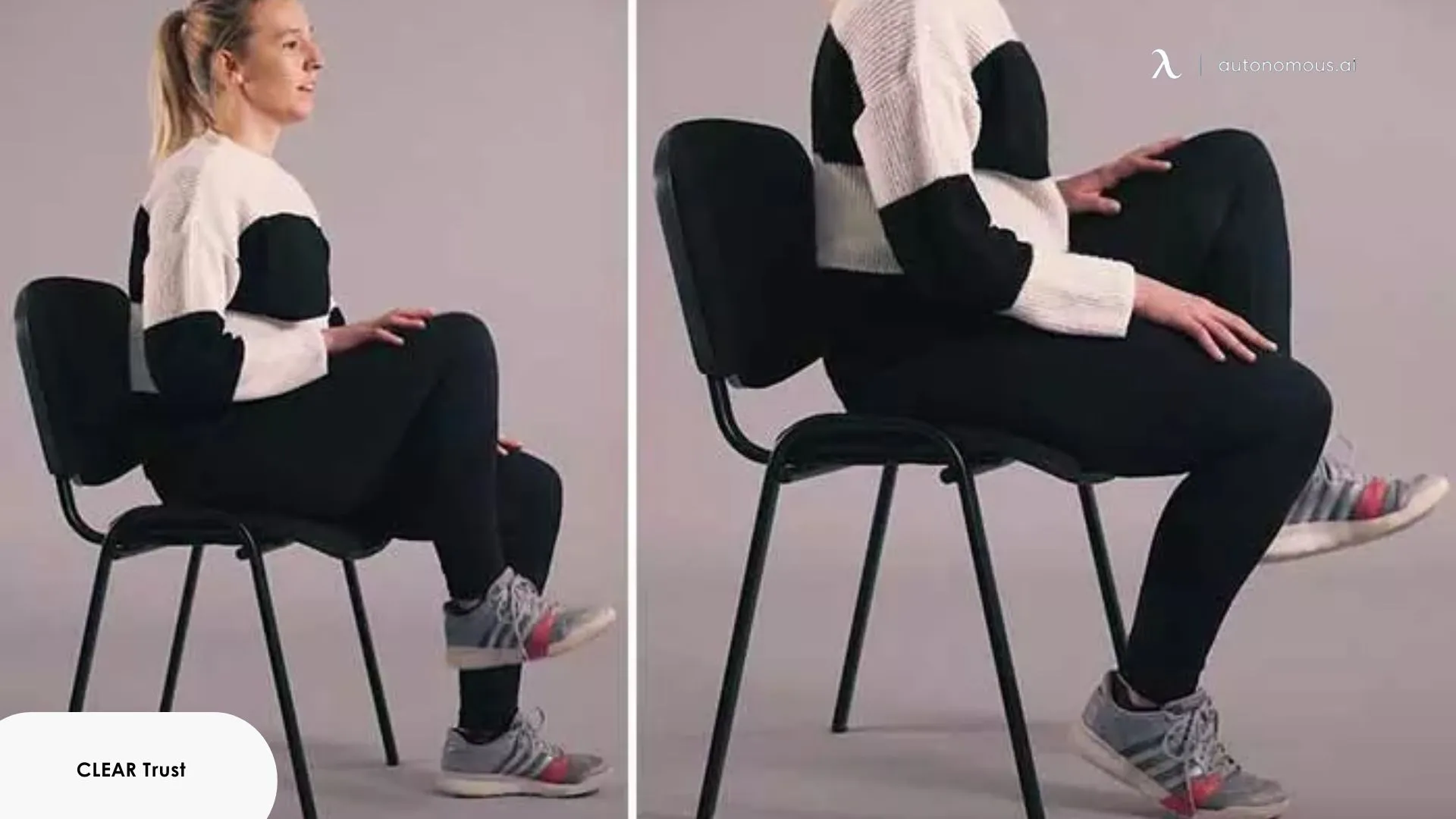
2. Seated Knee Extensions
A simple move to strengthen the front of your thighs so standing up and walking feel easier. This chair exercise for seniors targets the quadriceps, which are essential for independence.
Instructions: Do 8–10 reps per leg in 45 seconds, 15 seconds rest.
- Step 1: Sit up tall.
- Step 2: Straighten your right leg until almost straight.
- Step 3: Pause briefly.
- Step 4: Lower your foot.
- Step 5: Switch legs and repeat.
Safety notes: Don’t lock the knee; move only in a pain-free range.
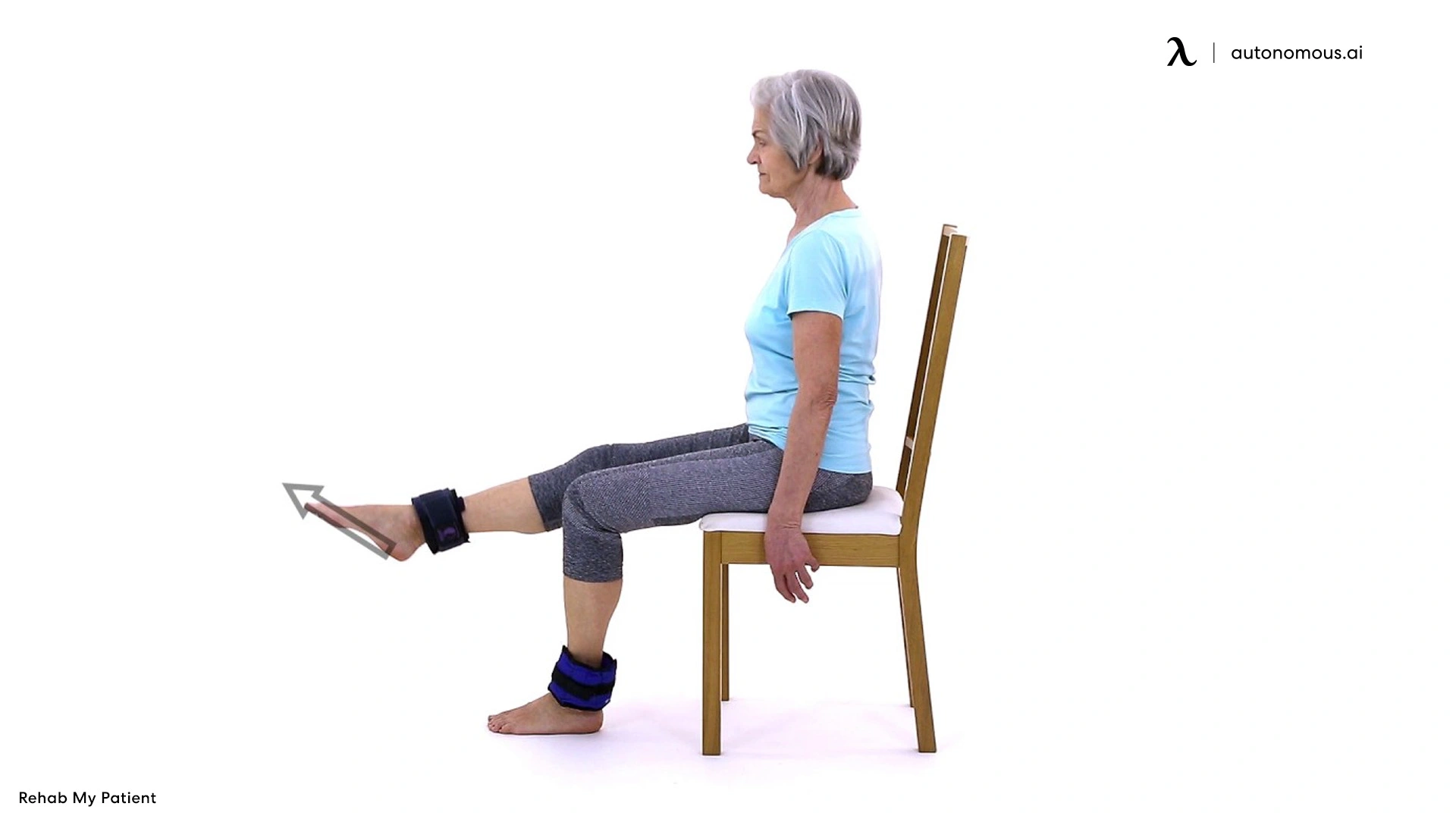
3. Heel Raises
Heel raises train the calf muscles that power the “push-off” phase of walking, so each step feels stronger and more controlled.
Instructions: Do 45 seconds work, 15 seconds rest.
- Step 1: Sit tall, feet flat.
- Step 2: Lift both heels high.
- Step 3: Lower slowly.
- Step 4: Repeat.
Safety notes: If calves cramp, shorten the range and slow the tempo.
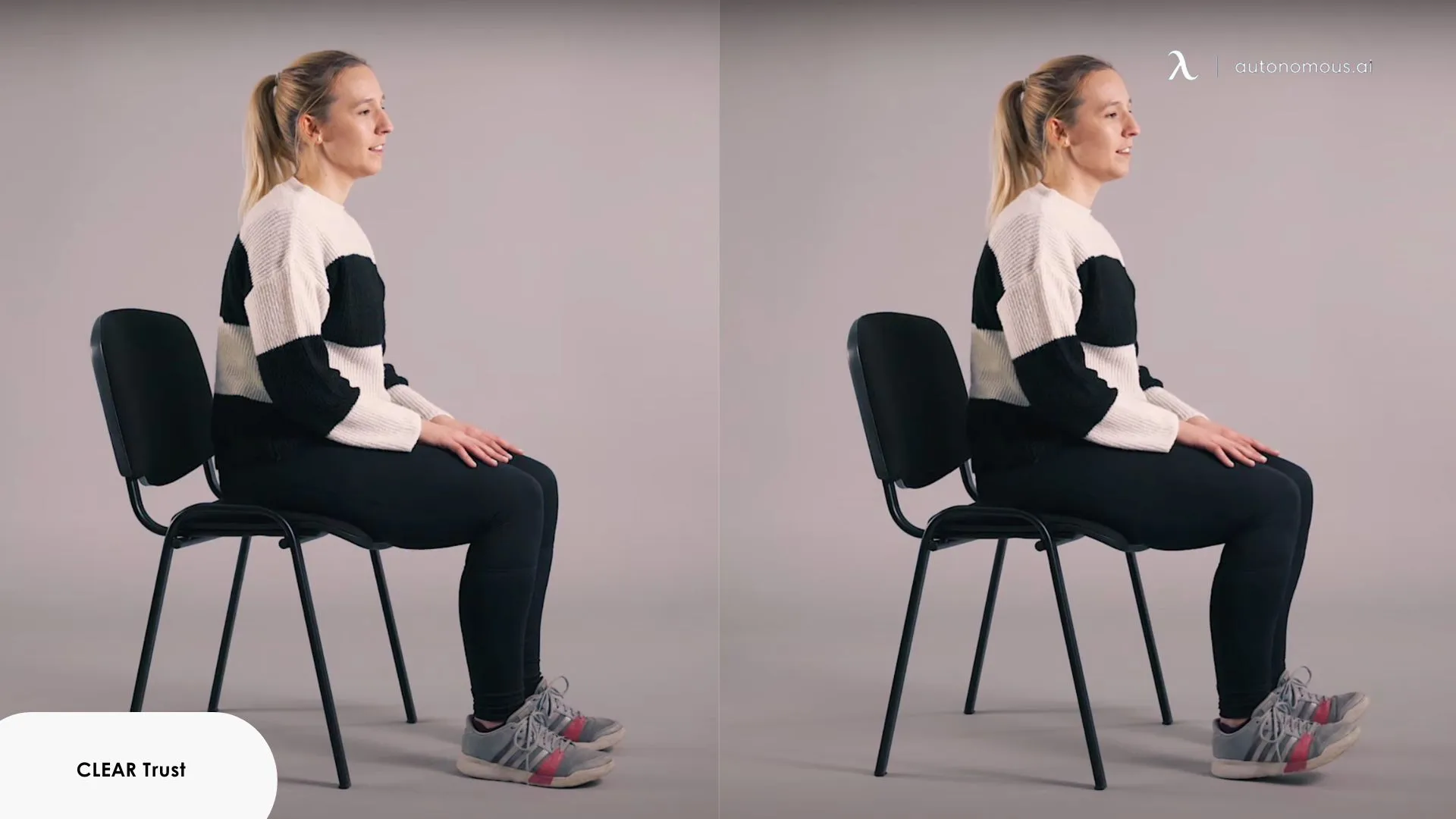
4. Ankle Circles
Limited ankle mobility is often linked to unsteady walking and balance issues. This gentle motion restores flexibility.
Instructions: Do 5–10 circles each way per ankle within 45 seconds, 15 seconds rest.
- Step 1: Lift your right foot slightly.
- Step 2: Circle the ankle clockwise, then counterclockwise.
- Step 3: Switch feet.
Safety notes: Move slowly. Stop if you feel pinching.
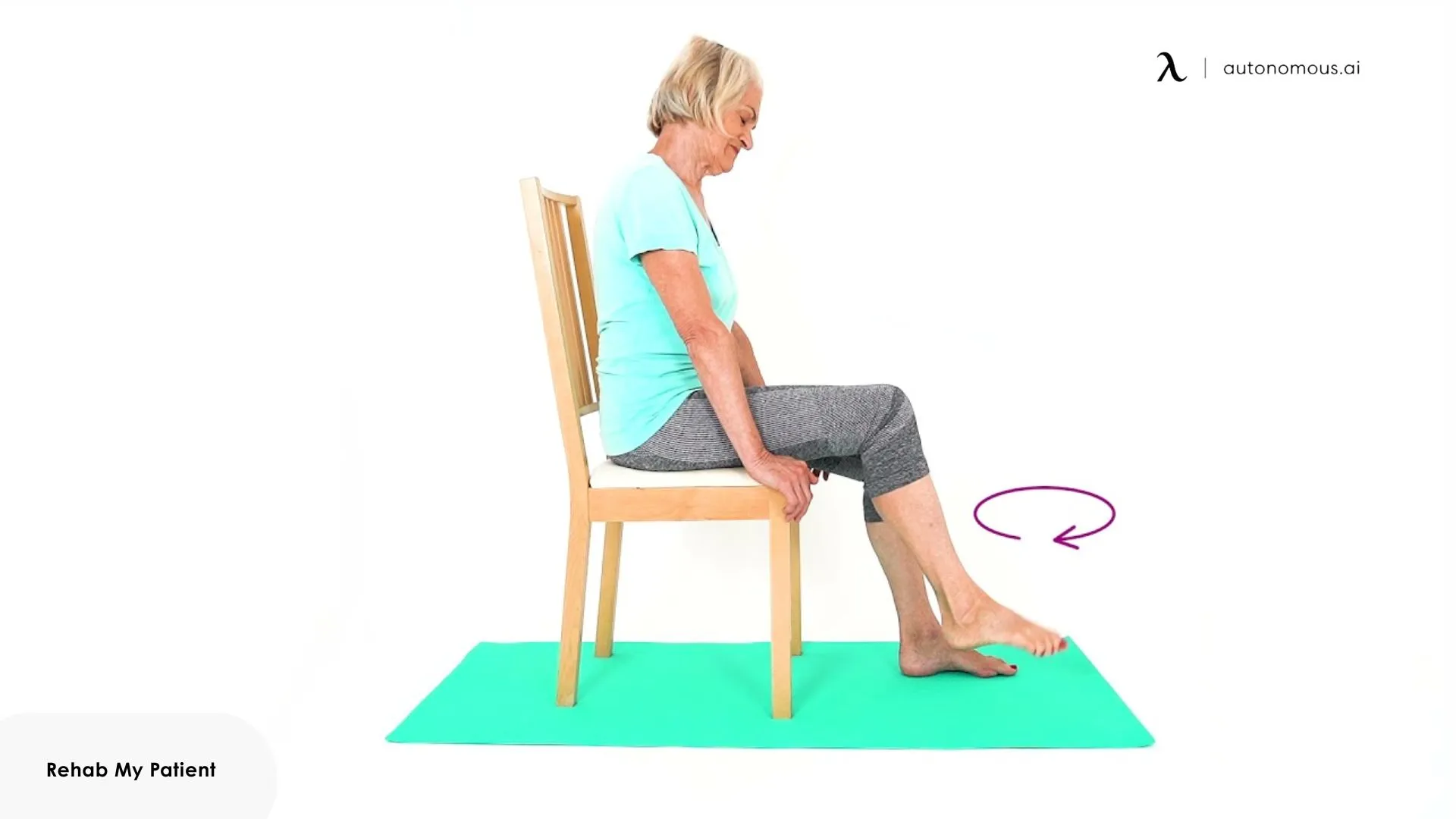
5. Sit-to-Stands
One of the most functional movements, sit-to-stands, builds leg strength and directly supports independence.
Instructions: Do 5–8 reps in 45 seconds, 15 seconds rest.
- Step 1: Scoot to the edge, feet under knees.
- Step 2: Lean forward a little.
- Step 3: Push through your heels to stand.
- Step 4: Sit back down with control.
Safety notes: If balance is a concern, keep one hand on the chair.
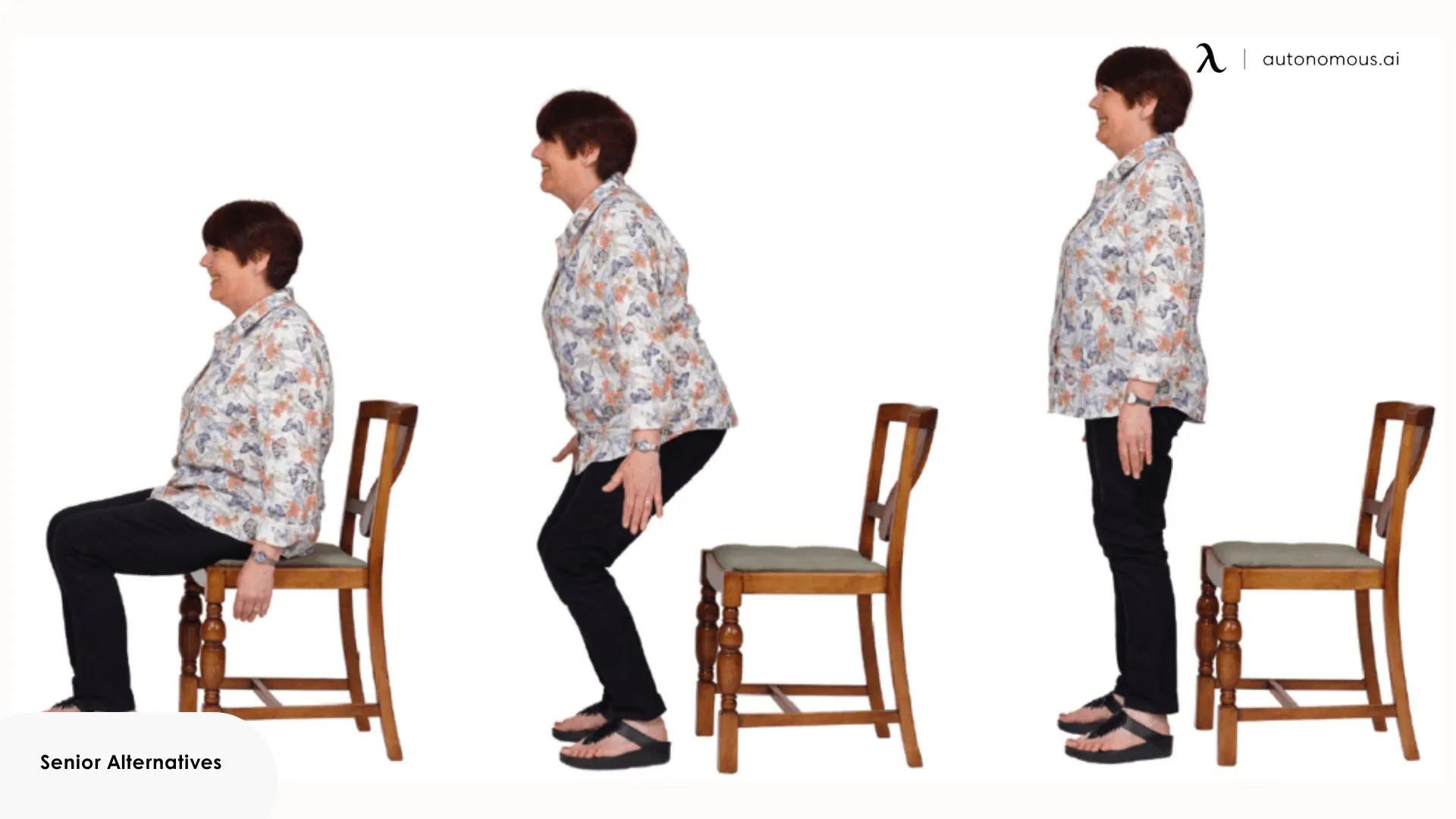
6. Seated Side Leg Lifts
This chair exercise for seniors strengthens the outer thighs and hips, areas that are essential for stability but often overlooked.
Set up note: Optional light loop band above knees.
Instructions: Do 8–10 reps per leg in 45 seconds, 15 seconds rest.
- Step 1: Sit tall.
- Step 2: Extend one leg straight out in front of you, keeping the knee straight and toes pointed upward.
- Step 3: Slowly move the extended leg out to the side as far as is comfortable, keeping your torso upright.
- Step 4: Bring the leg back to the center with control.
- Step 5: Repeat for the set, then switch to the other leg.
Safety notes: Keep the movement small if the hips feel tight.
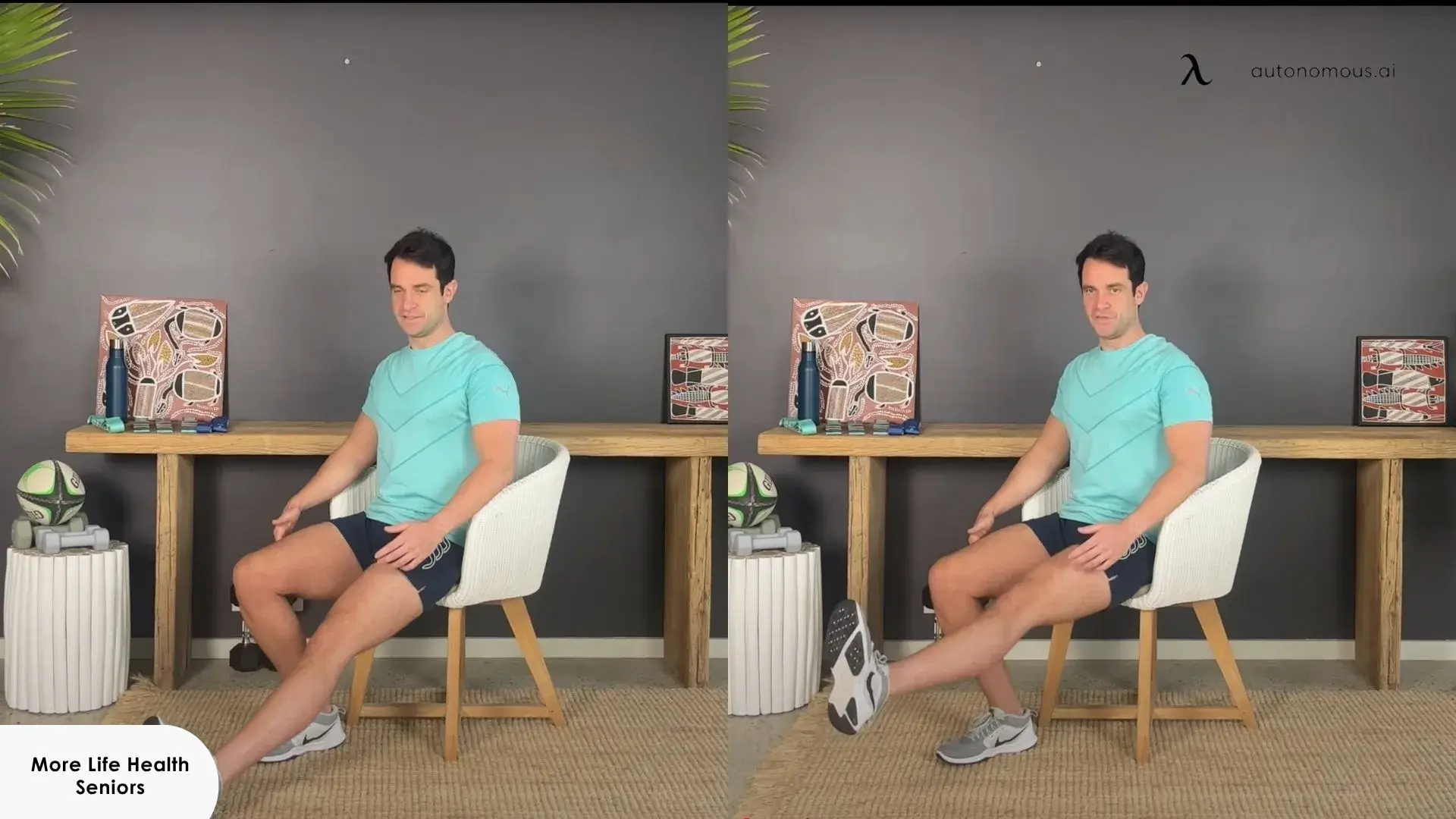
7. Sitting Hip Adduction
This movement engages the inner thighs and core to support better knee alignment and stability.
Instructions: Do 8–12 squeezes. Holding each for 3–5 seconds, and repeat for 2 rounds.
- Step 1: Sit tall on the front half of your chair with feet flat on the floor, slightly wider than hip-width.
- Step 2: Place one foot slightly across midline so your knees are angled inward.
- Step 3: Press your knees together gently, creating tension through the inner thighs.
- Step 4: Hold for 3–5 seconds, then release.
- Step 5: Repeat for the set, keeping the motion controlled and steady.
Safety notes: Use light pressure. No pain at the knees or groin.
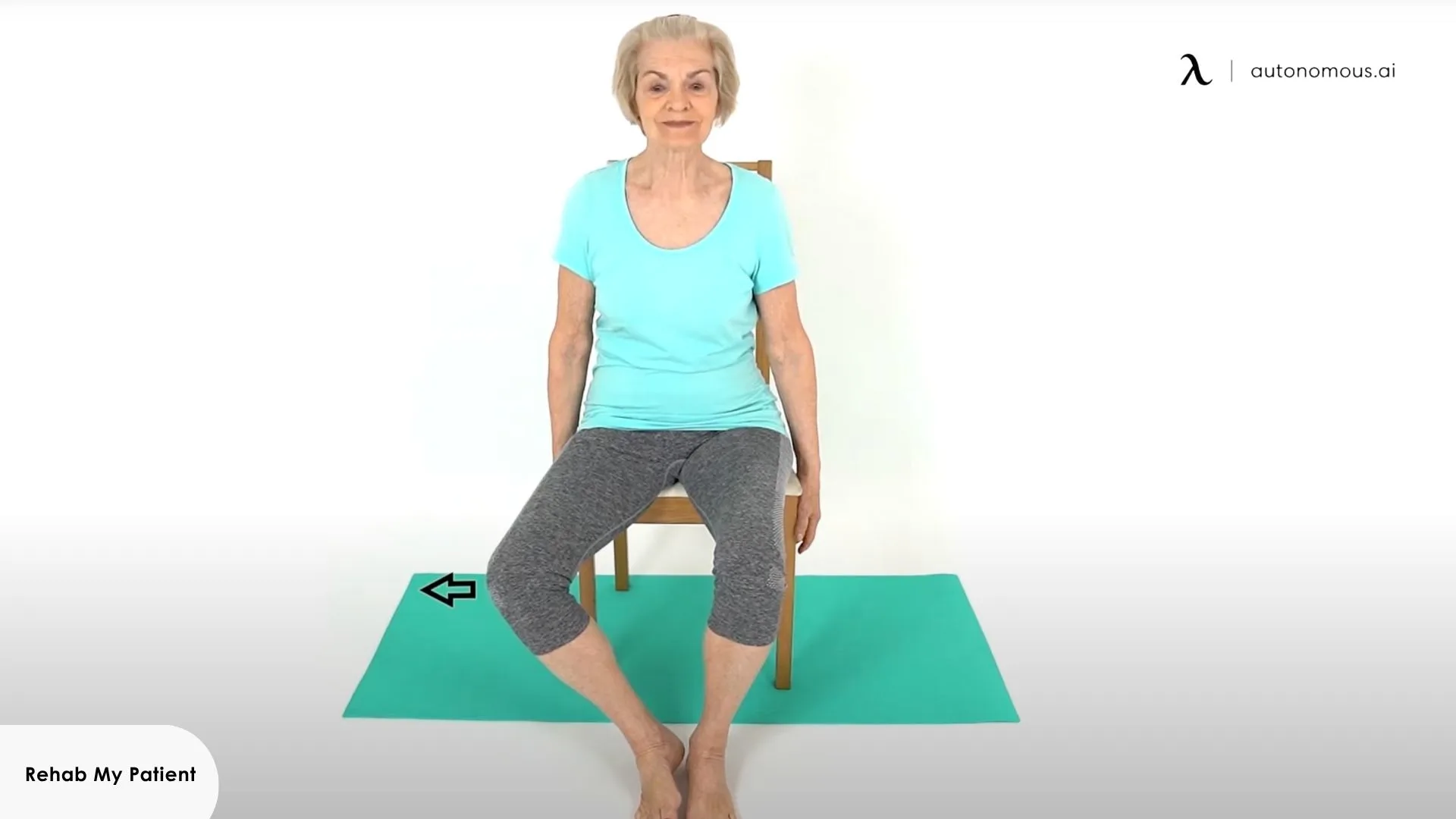
8. Seated Arm Raises
Shoulder stiffness is common in older adults. This simple exercise promotes flexibility and builds strength in the upper body.
Instructions: Do 8–12 reps in 45 seconds, 15 seconds rest.
- Step 1: Arms at sides.
- Step 2: Raise to shoulder height.
- Step 3: Lower slowly.
- Step 4: Repeat.
Safety notes: Stay below shoulder height if you feel pinching.
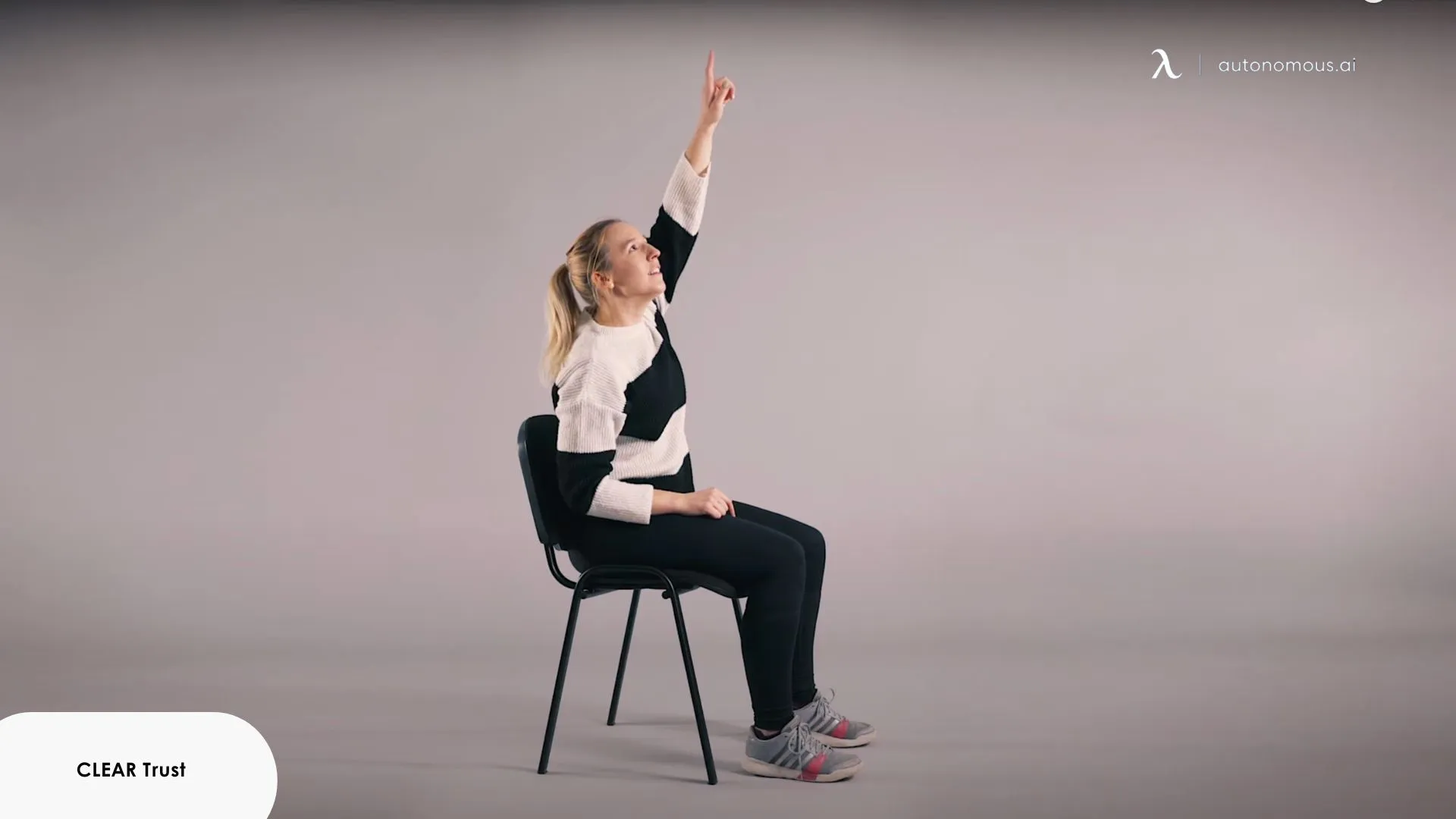
9. Seated Bicep Curls (with or without weights)
Upper-body strength is just as important as lower-body stability. Movements like chair exercises for upper body, including bicep curls, help maintain the strength needed for daily tasks such as carrying groceries, lifting objects, or even pushing up from a chair.
Instructions: Do 8–12 reps in 45 seconds, 15 seconds rest.
- Step 1: Sit tall, palms up.
- Step 2: Curl to your shoulders.
- Step 3: Lower with control.
- Step 4: Repeat.
Safety notes: Keep elbows close to your sides.
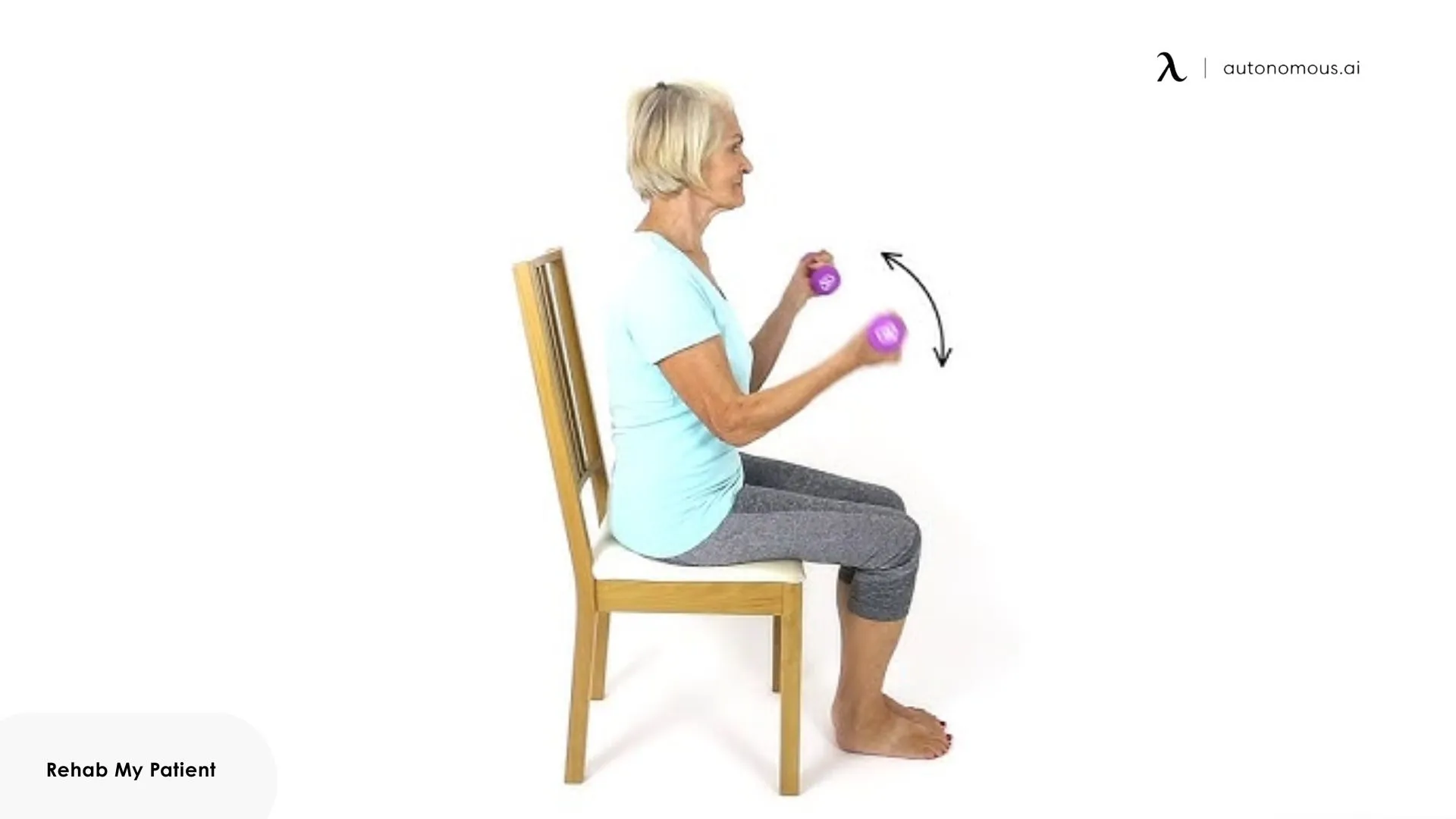
10. Triceps Presses
This strengthens the triceps, the primary muscles for elbow extension, so you can press down on the chair or armrests more effectively when standing up or shifting position.
Setup note: Use light weights or do gentle chair-edge push-backs without weights.
Instructions: Do 8–12 reps in 45 seconds, 15 seconds rest.
- Step 1: Hold weights at your sides.
- Step 2: Press arms straight back.
- Step 3: Return to the start.
- Step 4: Repeat.
Safety notes: Avoid shrugging. Keep shoulders relaxed.
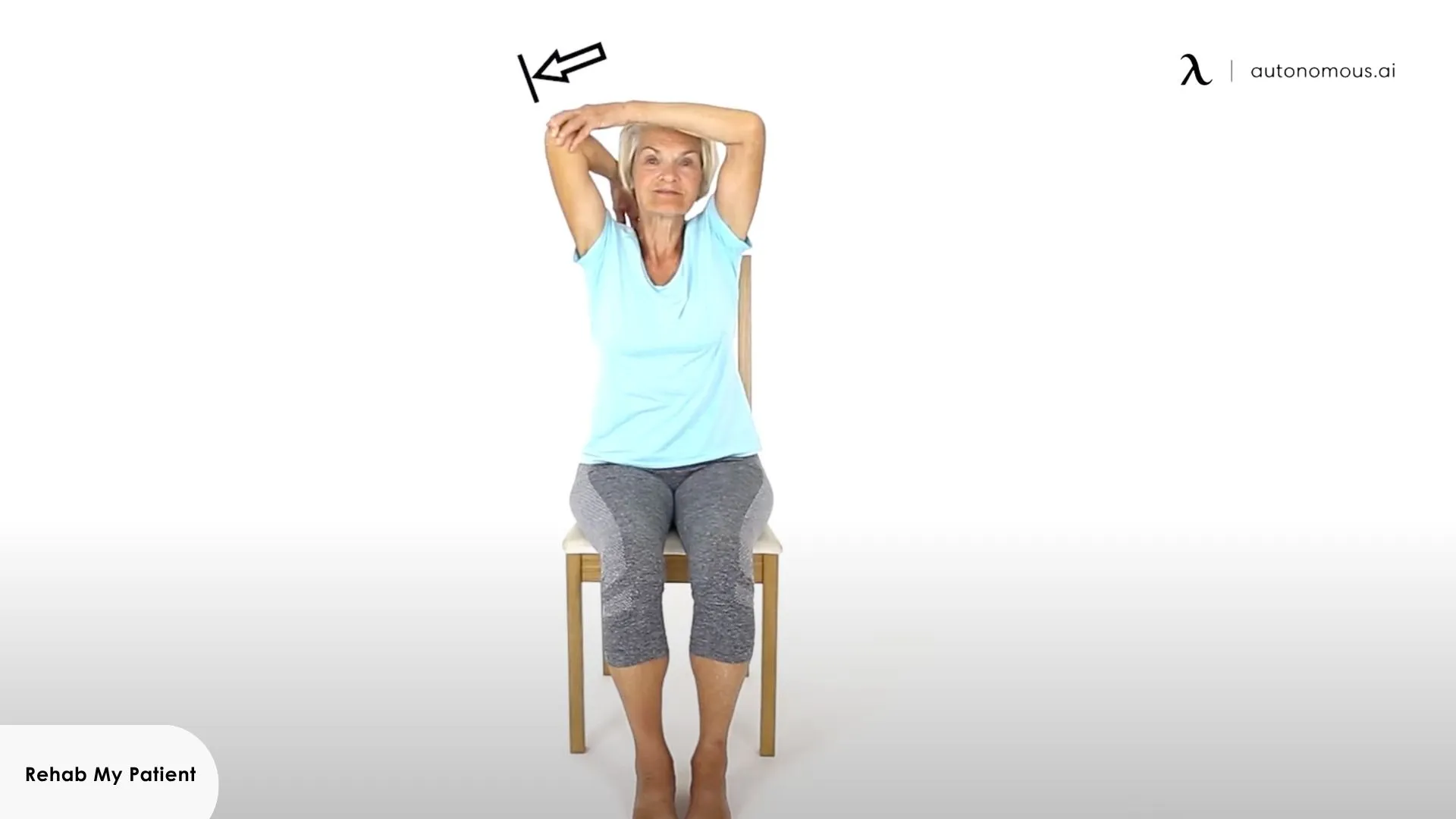
11. Seated Row with Band
They strengthen the mid-back and shoulder stabilizers, helping you sit taller and counter the rounded posture that comes with long hours of sitting. Stronger back muscles improve breathing mechanics and make daily reaching and lifting tasks easier.
Setup note: Loop a light band around your feet and hold the ends.
Instructions: Do 8–12 reps in 45 seconds, 15 seconds rest.
- Step 1: Sit tall.
- Step 2: Pull elbows back, squeeze shoulder blades.
- Step 3: Release slowly.
- Step 4: Repeat.
Safety notes: Keep band tension light and controlled.
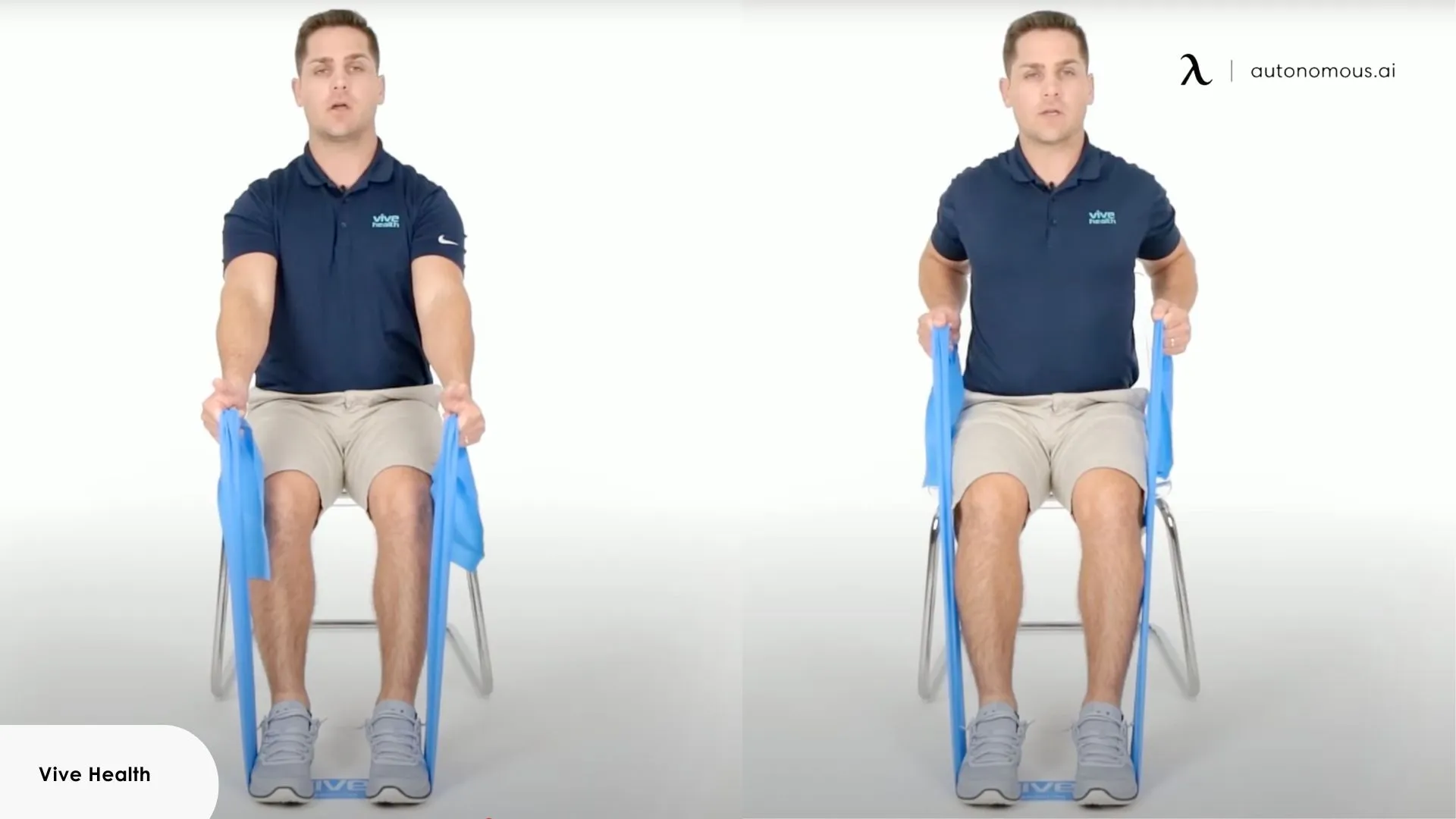
12. Seated Torso Twists
Core strength isn’t just about fitness — it’s about balance and spinal health. This movement keeps the midsection active and the spine flexible.
Instructions: Alternating twists for 45 seconds, 15 seconds rest.
- Step 1: Cross arms over chest.
- Step 2: Turn gently to the right.
- Step 3: Return to the center.
- Step 4: Turn left.
- Step 5: Repeat.
Safety notes: Move within a small, pain-free range
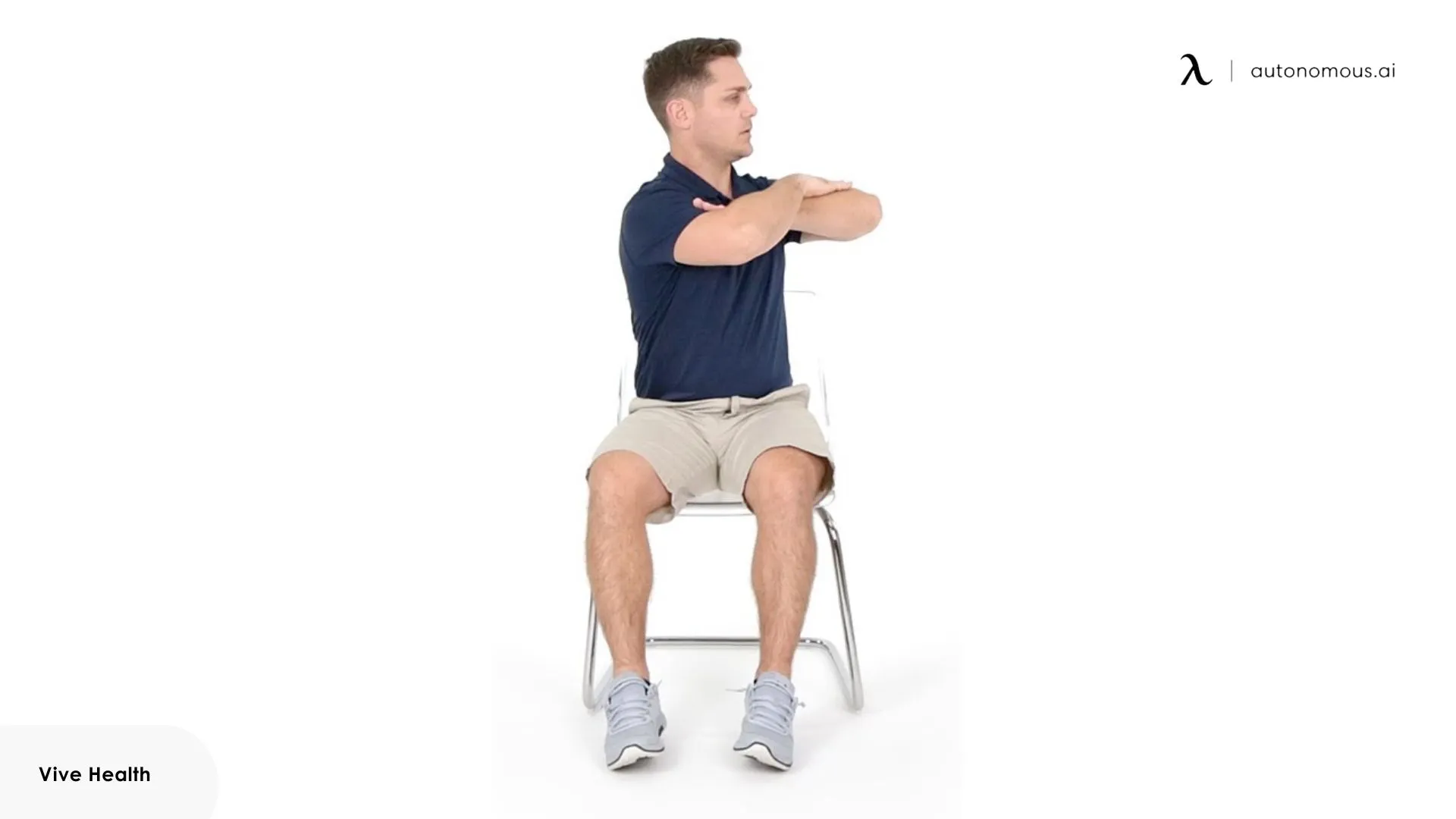
13. Seated Overhead Stretch
Flexibility often decreases with age, making it harder to reach for objects or maintain good posture. This stretch improves shoulder mobility and relieves stiffness in the upper body.
Step-by-step instructions:
- Sit comfortably with feet flat on the floor.
- Extend both arms upward toward the ceiling.
- Interlace your fingers and gently push your palms upward.
- Hold for 10–15 seconds, then relax.
- Repeat 3–5 times.
How it helps:
This stretch promotes flexibility in the shoulders and spine, helping seniors maintain better posture and reduce upper-back tension. It’s also a gentle way to counteract hours of sitting.
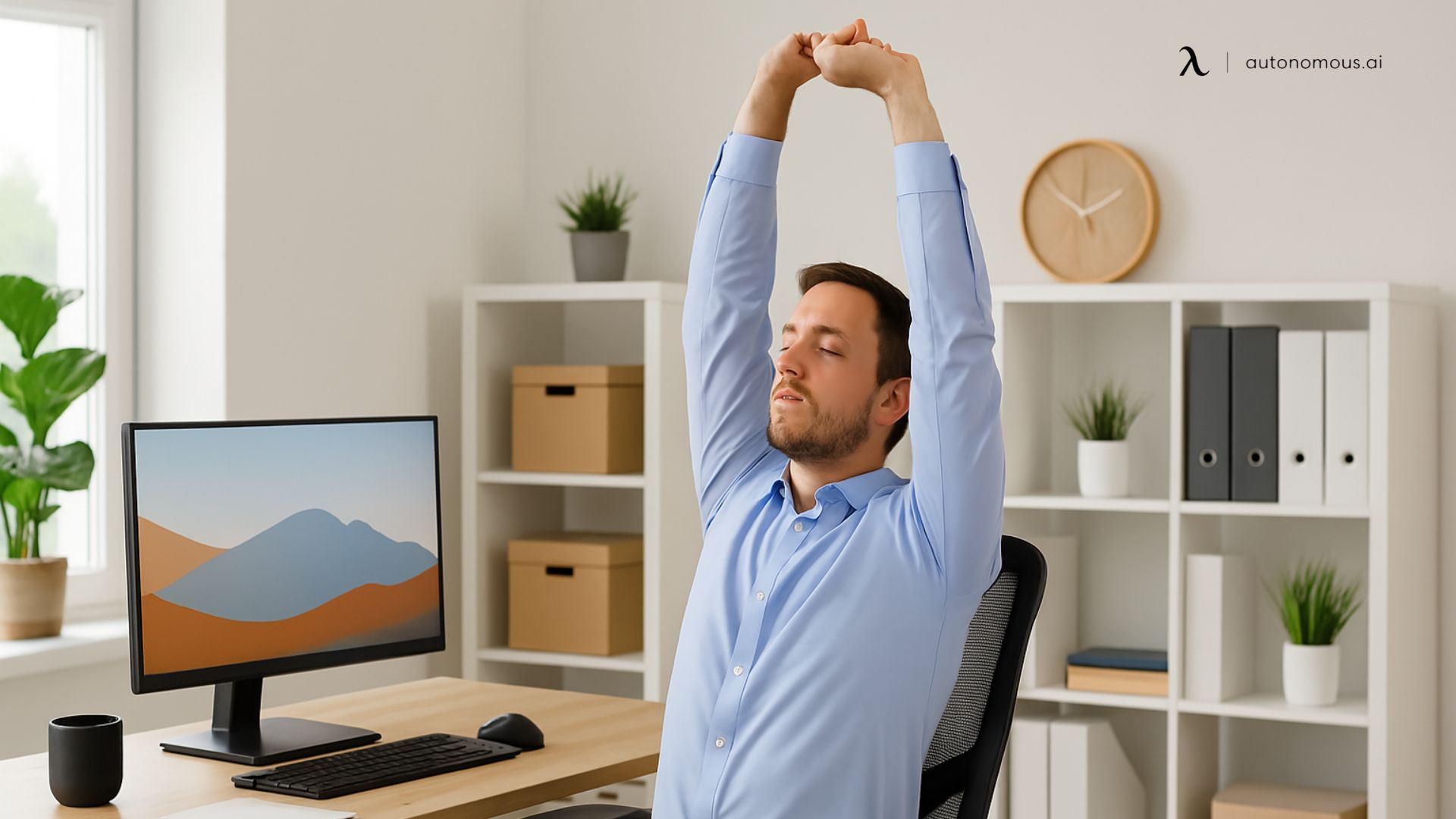
14. Seated Hamstring Stretch
This stretch lengthens the muscles behind the thighs, easing tension that can restrict walking stride. Flexible hamstrings improve balance, reduce risk of lower-back strain, and support safer, more confident steps.
Setup note: Extend one leg forward, heel on floor, toes up.
Instructions: Gentle holds within 45 seconds, 15 seconds rest.
- Step 1: Sit tall.
- Step 2: Hinge forward slightly until you feel a gentle stretch.
- Step 3: Hold, then switch legs.
Safety notes: Keep your back long. Do not bounce or push into pain.
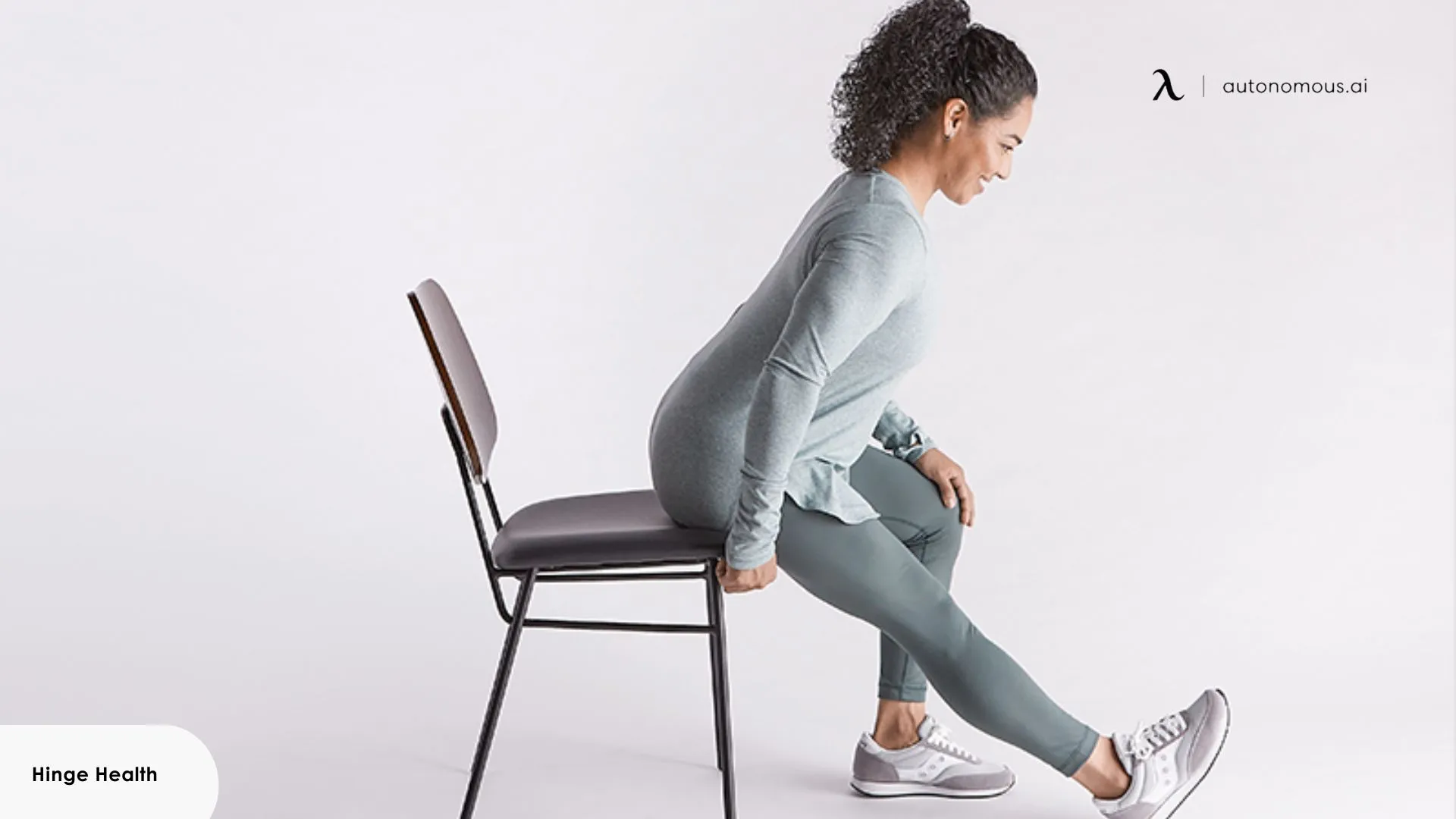
A Simple 10-Minute Chair Workout Chart For Seniors
If your day is packed, this 10-minute chair workout chart for seniors lets you practice chair exercises for seniors quickly and safely. Follow the timeline below to warm up, build strength, and finish with gentle stretches—all from a sturdy chair. Use it on busy days, then rotate in the 15-minute chair exercises for seniors when you have more time.
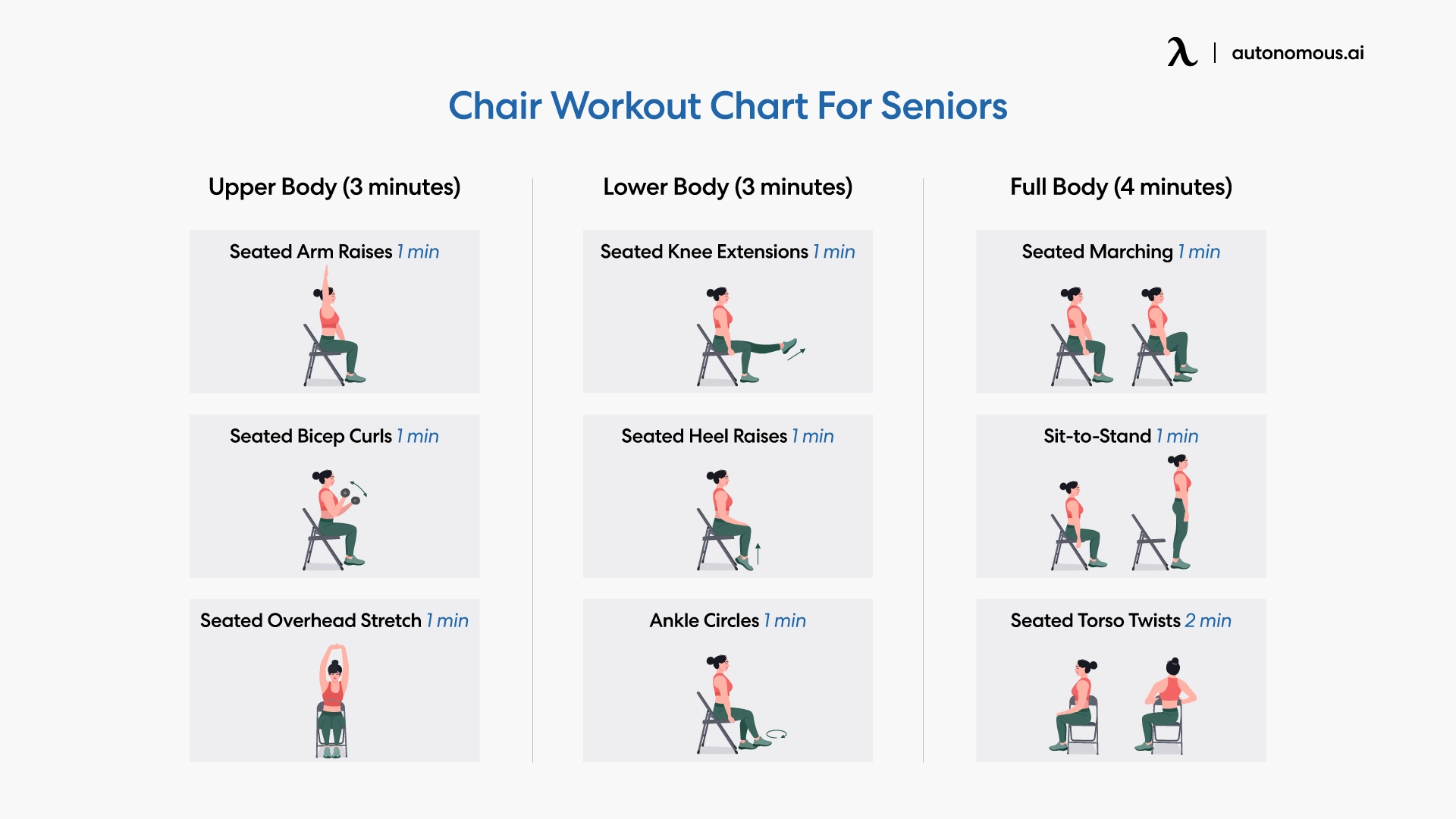
FAQs
1. Do chair workouts really work for seniors?
Yes, chair workouts are highly effective for seniors. They build strength, improve balance, increase flexibility, and boost circulation—all while being low-impact and gentle on the joints. Even 10 to 15 minutes of regular chair exercises for seniors can support mobility and independence.
2. What chair is best for chair exercises for seniors?
The best chair for chair exercises for seniors is a sturdy, armless chair without wheels. Look for a flat, firm seat with a supportive backrest. Place it on a non-slip surface or against a wall for extra stability. Avoid soft, cushioned chairs since they reduce support and can shift during exercise.
3. What are some good chair exercises for seniors?
Good chair exercises for seniors include seated marching, knee extensions, sit-to-stands, ankle circles, arm raises, torso twists, and bicep curls. These moves target major muscle groups, improve posture, and are often used in 10-minute chair workouts for seniors.
4. Do seated exercises work for seniors?
Yes. Seated exercises allow seniors with balance concerns or reduced mobility to safely engage muscles and stay active. They help improve posture, joint health, and cardiovascular endurance without the risks of standing workouts.
5. What is the number one exercise for elderly people?
The sit-to-stand is considered the most important chair exercise for seniors. It strengthens the legs, hips, and core, directly supporting independence for daily tasks like rising from a chair or using stairs.
6. Is there a free app for chair exercises for seniors?
Yes. Seniors can find free chair exercise routines on YouTube and in wellness apps like SilverSneakers GO. Many programs also provide printable 10-minute or 15-minute chair exercises for seniors for easy follow-along use at home.
7. How do you exercise while sitting in a chair?
Exercising while seated is simple—lift your knees, extend your legs, twist your torso, raise your arms, or tap your toes. These chair exercises for seniors strengthen muscles, improve flexibility, and can be done in short routines like a 7-minute chair workout or a 15-minute session.
8. Can you lose belly fat by doing exercises on a chair?
Chair exercises for seniors can help burn calories, strengthen core muscles, and improve posture, all support weight management. However, no single exercise can “spot reduce” belly fat. The best results come from combining chair workouts with regular movement, a balanced diet, and overall healthy habits.
9. Is a 10-minute chair workout for seniors effective?
Yes, a 10-minute chair workout for seniors can be highly effective. Just 10 minutes of consistent chair exercises builds leg and core strength, supports balance, and increases mobility while remaining joint-friendly. Combining movements like sit-to-stands, bicep curls, and seated stretches creates a full-body routine that supports independence and healthy aging.
10. What is a good 7-minute chair workout for seniors?
A 7-minute chair workout for seniors is a quick routine of safe, low-impact moves that improve circulation, strength, and flexibility in under 10 minutes. Popular exercises include seated marching, ankle circles, knee extensions, heel raises, and gentle torso twists.
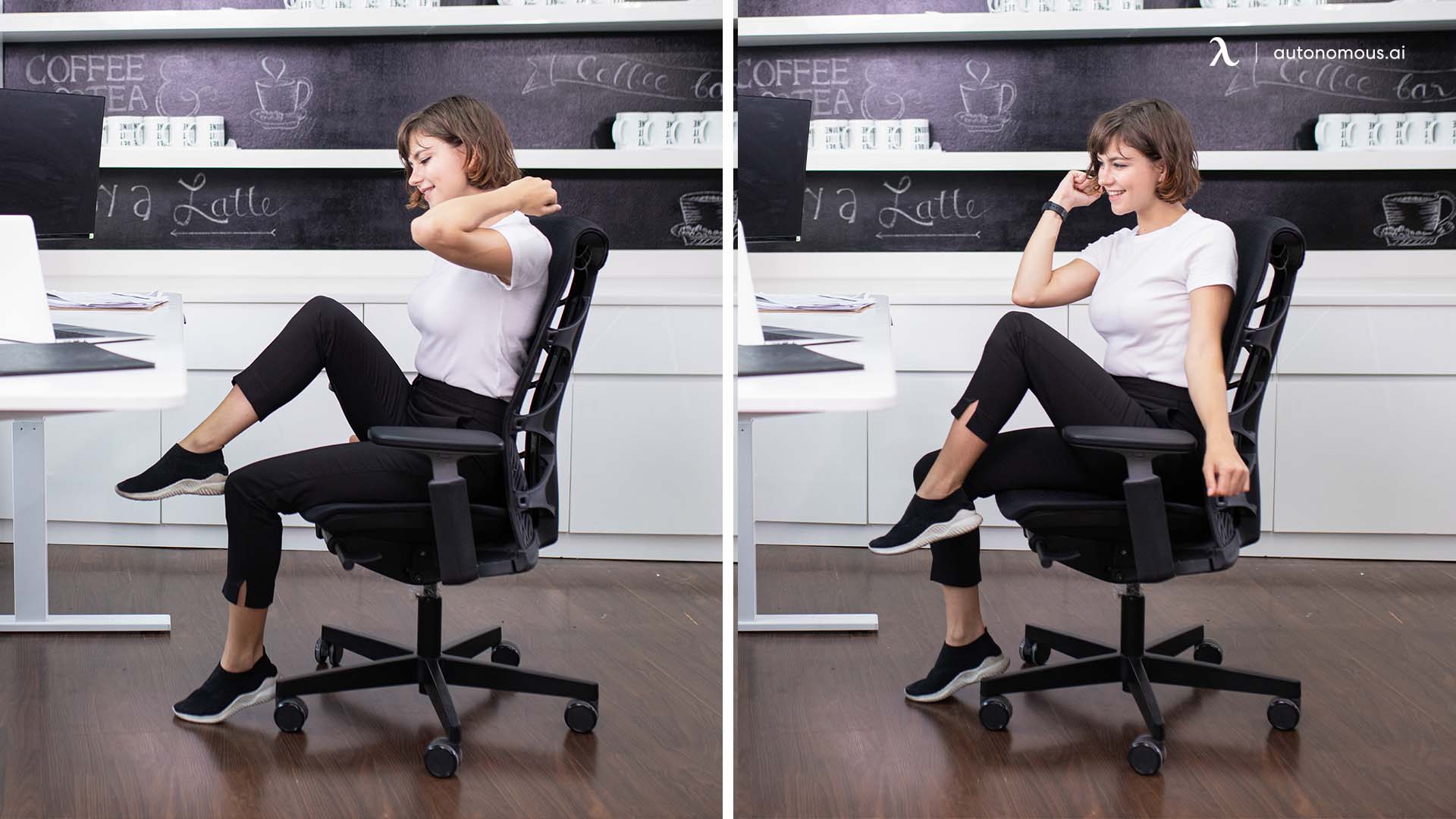
Final Remarks
Staying active doesn’t have to mean high-impact workouts or long hours at the gym. For older adults, 15-minute chair exercises for seniors provide a safe and effective way to build strength, improve flexibility, and support overall well-being. From simple leg extensions to gentle seated back stretches, these movements help maintain independence and make daily tasks easier.
If you have specific goals, there are plenty of focused options: chair exercises for weight loss can encourage calorie burn, chair workouts for men emphasize strength and mobility, and chair exercises for belly fat target the core. Each variation can be adapted to match your comfort level, time, and fitness needs.
For an all-day boost, you can also explore active sitting, where an ergonomic active chair promotes gentle micro-movements, keeping your core engaged and posture supported even while seated. Pairing active sitting with regular chair routines multiplies the benefits.
The key is consistency — even a few minutes each day can bring meaningful benefits. With the right chair and a routine you enjoy, healthy aging becomes not only possible but empowering.
.svg)


